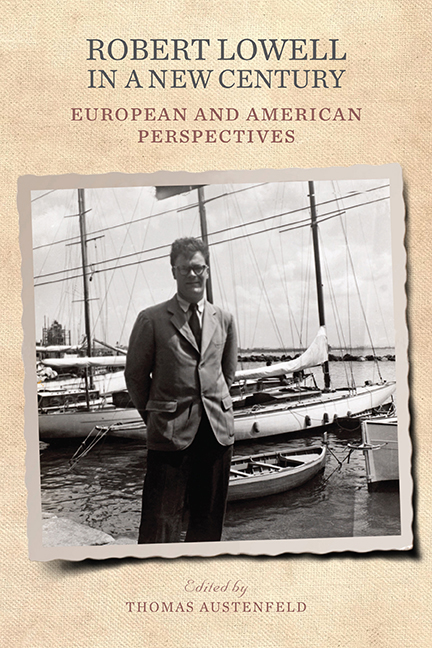Book contents
- Frontmatter
- Dedication
- Contents
- Acknowledgments
- Introduction
- 1 Revisiting Robert Lowell's Mental Hospital Poems
- 2 Sensual Drift and Ethnic Longing in Robert Lowell
- 3 Reworking the Same Water: Robert Lowell Transported
- 4 “Sweet salt embalms me”: A Hippocratic Approach to the Role of the Sea in the Poetry of Robert Lowell
- 5 More Delicate Than the Historian's Are the Map-Maker's Colors: Correspondences between Lowell's Poetics of History and Bishop's Poetics of Space
- 6 Robert Lowell and Ezra Pound's Economics
- 7 Robert Lowell and Ezra Pound in Washington and Rapallo
- 8 “Why Holland?”: Robert Lowell in Amsterdam
- 9 Lowell and Ungaretti: Imitations and Beyond
- 10 Robert Lowell's Credo
- 11 “Marriage? That's another story”: Reconsidering the Marital Trope in Robert Lowell's Poetry
- 12 “Oh No”/“Yes Yes”: Lowell and the Making of Mistakes
- 13 Robert Lowell: The Power of Influence
- Notes on Contributors
- Index
8 - “Why Holland?”: Robert Lowell in Amsterdam
Published online by Cambridge University Press: 26 June 2019
- Frontmatter
- Dedication
- Contents
- Acknowledgments
- Introduction
- 1 Revisiting Robert Lowell's Mental Hospital Poems
- 2 Sensual Drift and Ethnic Longing in Robert Lowell
- 3 Reworking the Same Water: Robert Lowell Transported
- 4 “Sweet salt embalms me”: A Hippocratic Approach to the Role of the Sea in the Poetry of Robert Lowell
- 5 More Delicate Than the Historian's Are the Map-Maker's Colors: Correspondences between Lowell's Poetics of History and Bishop's Poetics of Space
- 6 Robert Lowell and Ezra Pound's Economics
- 7 Robert Lowell and Ezra Pound in Washington and Rapallo
- 8 “Why Holland?”: Robert Lowell in Amsterdam
- 9 Lowell and Ungaretti: Imitations and Beyond
- 10 Robert Lowell's Credo
- 11 “Marriage? That's another story”: Reconsidering the Marital Trope in Robert Lowell's Poetry
- 12 “Oh No”/“Yes Yes”: Lowell and the Making of Mistakes
- 13 Robert Lowell: The Power of Influence
- Notes on Contributors
- Index
Summary
IN LATE SEPTEMBER 1951, Robert Lowell and Elizabeth Hardwick arrived in Amsterdam for an extended stay that lasted half a year. While many American literary friends, who also traveled to Europe that year, preferred more cosmopolitan cities such as Paris, Rome, and Venice (which Lowell and Hardwick also visited), Lowell stubbornly insisted on staying in the war-torn and provincial Dutch capital, which was not the hip and international hub that it became after the 1960s. “At this point you must be saying ‘why Holland?’” he wrote to Elizabeth Bishop, adding, “Everyone has.” This essay seeks to understand why Lowell insisted on staying in Amsterdam for such a long period, which Hardwick initially found “dull and depressing,” and how Amsterdam impacted Lowell's life and art. Lowell partly answered his own question in advance, when trying to convince Hardwick a few weeks before settling in Amsterdam: “The Anglo-Saxon's encounter with the Latin cultures has been worn to exhaustion,” he wrote: “Holland draws me because of the novelty, the freedom to pick and choose and the privacy which is so necessary for reactions that are at all personal or profound. The paintings, Motley, and my own Protestant New England background give me a host of other suggestions. I feel I can make something out of living in Holland—one can never know, but the hunch seems crucially worth following.” Lowell was well prepared for his visit to the Low Countries. As a teenager he had already scribbled his first poem about Rembrandt, and more recently he had started reading the voluminous Rise of the Dutch Republic (1855) by fellow Bostonian John Lothrop Motley. Lowell's “Protestant New England background” had indeed been affected by the tolerant Dutch Republic of the seventeenth- century Golden Age. One of his Pilgrim ancestors, Edward Winslow, found refuge in Leyden and even got married there before embarking on his Mayflower voyage to the New World.
Although Lowell's idiosyncratic choice to relocate to the Netherlands in 1951 is understandable, my approach to studying how Lowell's stint in Amsterdam influenced his work is counterintuitive. In spite of his “hunch” that he could “make something out of living in Holland,” Lowell was woefully unproductive in that city, heralding in a dry spell—following the publication of The Mills of the Kavanaughs earlier that year—that would last until Life Studies (1959).
- Type
- Chapter
- Information
- Robert Lowell in a New CenturyEuropean and American Perspectives, pp. 105 - 116Publisher: Boydell & BrewerPrint publication year: 2019



